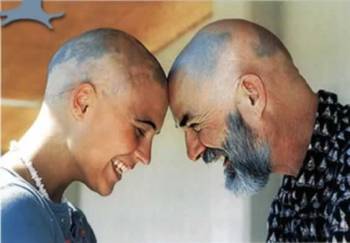Alopecia Areata
 Alopecia areata is an skin condition in which hair is lost from some or all areas of the body, usually from the scalp. Alopecia areata, as a rule, is rarely associated with any other external or internal medical problems. Most often these bald areas regrow their hair spontaneously.
Alopecia areata is an skin condition in which hair is lost from some or all areas of the body, usually from the scalp. Alopecia areata, as a rule, is rarely associated with any other external or internal medical problems. Most often these bald areas regrow their hair spontaneously.
In 1–2% of cases, the condition can spread to the entire scalp (Alopecia totalis) or to the entire skin (Alopecia universalis). Alopecia areata affects both males and females. It tends to occur most often in children and young adults but older individuals can be affected as well.
What Causes Alopecia Areata?
Its actual cause is unknown, but it is believed to be an autoimmune condition, in which a misguided immune system attacks the hair follicles and disrupts normal hair growth. Evidence for this comes from biopsies of affected skin show immune lymphocytes penetrating into the hair bulb of the hair follicles.
Alopecia areata is also associated with other autoimmune conditions such as thyroid disease, vitiligo, lupus, rheumatoid arthritis, and ulcerative colitis. Sometimes, it occurs within families, suggesting a genetic component.
Signs & Symptoms:
Alopecia areata typically begin as small bald patches, with the bald patches looking unscarred and superficially normal. These patches can take many shapes, but are most usually round or oval. Occasionally the areas of hair loss may tingle.
The hair tends to fall out over a relatively short period of time, with bald patches typically occurring more on one side of the scalp than the other. Exclamation point hairs (diagnostic of alopecia areata) can be found in areas of hair loss and are seen as short broken off hairs that are narrower closer to the scalp, and therefore mimic an exclamation point.
Hairs along the edge of the bald patch tend to pull out more easily, and these are the hairs of which the follicles are already being attacked by the immune system.
Nails may also show some pitting.
Diagnosis:
Alopecia areata is usually diagnosed based on clinical findings. Very occasionally, your doctor may recommend a biopsy. Histologically, peribulbar lymphocytic infiltrates resembling a "swarm of bees" may be seen. In inactive alopecia areata, one may not find any inflammatory infiltrates.
Treatment:
Treatment is not always necessary because the condition is benign, and spontaneous remissions and recurrences are common. Treatments used are believed to stimulate hair growth, but they generally do not influence the ultimate natural course of alopecia areata. Treatment modalities usually are considered first according to the extent of hair loss and the patient's age.
Mild, Patchy Alopecia Areata
If the affected region is small, it is reasonable to observe the progression of the illness as the problem often spontaneously regresses and the hair may grow back. Whilst there are several treatment options that have been around for many years, there is currently no one universally acceptable treatment that works in all cases.
1. Cortisone injections: The most common treatment is the injection of cortisone into the bare skin patches. Steroid injections are given just under the skin on several points around the bare patches using a very small needle. This is repeated about once a month. If new hair growth does occur, it is usually visible after about 4 weeks. Note however, that treatment does not prevent new patches from forming.
2. Topical Steroid Creams/Lotions: Initial stages may be kept from increasing by applying topical corticosteroids. However, topical corticosteroids frequently fail to enter the skin deeply enough to affect the hair bulbs, which are the treatment target.
3. Topical Minoxidil: Topical minoxidil solution (5%) applied twice daily may stimulate hair growth. If scalp hair regrows completely, treatment can be stopped. Occasionally, there may be local sensitivity reaction to minoxidil, presenting as an itchy rash.
4. Anthralin Cream/Ointment: Anthralin is one of the non-specific irritants known for inducing hair growth. Typically, a 0.5% anthralin is applied in liquid or cream form. After a specified duration of treatment, it is washed away.
Alopecia Areata Totalis and Alopecia Areata Universalis
Fewer treatment options are available for extensive alopecia.
1. Oral Steroids: Oral steroids are sometimes prescribed for extensive scalp hair loss. However, it is infrequently used due to the health risks from prolonged steroid use. Also, regrown hair has been known to fall out once the oral steroids are stopped.
2. Topical Immunotherapy: Another method of treating extensive alopecia areata is known as topical immunotherapy. It involves producing and allergic rash or allergic contact dermatitis, and this is thought to stimulate hair growth.
3. Wigs: As treatments tend to be much less effective for extensive alopecia areata, wigs are an important option for some people.
The article above is meant to provide general information and does not replace a doctor's consultation.
Please see your doctor for professional advice.
